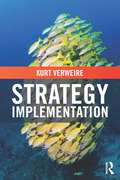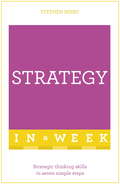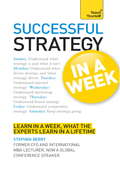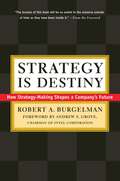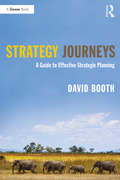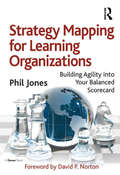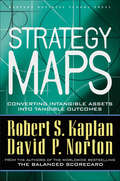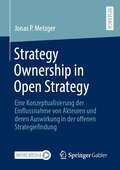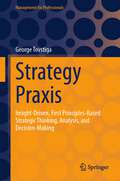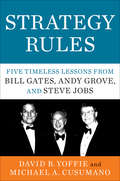- Table View
- List View
Strategy Implementation: A Guide To Strategy Implementation
by Kurt VerweireStrategy implementation - or strategy execution - is a hot topic today. Managers spend significant resources on consulting and training, in the hope of creating brilliant strategies, but all too often brilliant strategies do not translate into brilliant performance. This book presents new conceptual models and tools that can be used to implement different strategies. The author analyses how market leaders have benefitted from successful strategy implementation and provides the reader with a comprehensive and systematic framework to tackle strategy implementation challenges. Have clear strategic choices been made? Are actions aligned with the strategy? What’s the organizational context for the strategy? In answering these simple questions, the book provides students of strategic management, along with managers involved in designing and implementing strategies, with a valuable resource.
Strategy In A Week: Strategic Thinking Skills In Seven Simple Steps
by Stephen BerryStrategic thinking just got easierFor most aspiring managers, at some point in their careers, their Personal Development Plans will include the demand to have 'greater strategic thinking ability'. We have the perception that executives operating at board-level have this 'strategic thinking ability' but seldom find the route to obtain it for ourselves. The purpose of this book is to provide that route. Strategy, like any other discipline, can be learned and practised. This book takes you on a journey to explore what organizational strategy is, where it fits within the context of each business, and then gives an examination of internal, external, marketing, brand and competitive strategy. To progress to an executive position, a wide range of skills and attributes are required. Aspects such as good leadership skills, strong communication skills, commercial understanding and the ability to understand other people are all needed. Equal with these vital elements is the ability to have a good grasp of strategic thinking. Strategy In A Week provides the platform for you to acquire the vital skills of strategic thinking. Whether you choose to read it in a week or in a single sitting, this is your fastest route to success:- Sunday: Understand what strategy is and what it isn't- Monday: Understand what drives strategy and what strategy drives- Tuesday: Understand internal strategy- Wednesday: Understand marketing strategy- Thursday: Understand brand strategy- Friday: Understand competitive strategy- Saturday: Keep strategy going
Strategy In A Week: Strategic Thinking Skills In Seven Simple Steps
by Stephen BerryStrategic thinking just got easierFor most aspiring managers, at some point in their careers, their Personal Development Plans will include the demand to have 'greater strategic thinking ability'. We have the perception that executives operating at board-level have this 'strategic thinking ability' but seldom find the route to obtain it for ourselves. The purpose of this book is to provide that route. Strategy, like any other discipline, can be learned and practised. This book takes you on a journey to explore what organizational strategy is, where it fits within the context of each business, and then gives an examination of internal, external, marketing, brand and competitive strategy. To progress to an executive position, a wide range of skills and attributes are required. Aspects such as good leadership skills, strong communication skills, commercial understanding and the ability to understand other people are all needed. Equal with these vital elements is the ability to have a good grasp of strategic thinking. Strategy In A Week provides the platform for you to acquire the vital skills of strategic thinking. Whether you choose to read it in a week or in a single sitting, this is your fastest route to success:- Sunday: Understand what strategy is and what it isn't- Monday: Understand what drives strategy and what strategy drives- Tuesday: Understand internal strategy- Wednesday: Understand marketing strategy- Thursday: Understand brand strategy- Friday: Understand competitive strategy- Saturday: Keep strategy going
Strategy In A Week: Strategic Thinking Skills In Seven Simple Steps
by Stephen BerryThe ability to develop and implement a successful strategy is crucial to anyone who wants to advance their career. Written by Stephen Berry, a leading expert on strategy as both a coach and a practitioner, this book quickly teaches you the insider secrets you need to know to in order to build a winning strategy. The highly motivational 'in a week' structure of the book provides seven straightforward chapters explaining the key points, and at the end there are optional questions to ensure you have taken it all in. There are also cartoons and diagrams throughout, to help make this book a more enjoyable and effective learning experience. So what are you waiting for? Let this book put you on the fast track to success!
Strategy Is Destiny: How Strategy-Making Shapes a Company's Future
by Robert A. BurgelmanHow did a pioneering company in the semiconductor industry not only survive but thrive in the face of the explosive change and upheavals that forced it to transform itself twice in the course of its thirty-year history? The answer lies in the quality of its strategy-making process, contends leading strategic management scholar Robert A. Burgelman in this extraordinary book based on an exhaustive twelve-year study he conducted inside Intel Corporation. Granted the opportunity to track Intel's strategy-making through his close teaching collaboration with its chairman, Andy Grove, at Stanford Business School since 1988, Burgelman has written a definitive and far-reaching account of how highly educated top managers groped their way through strategic conundrums. His account of the evolution of key events in Intel's history is illustrated with extensive quotes from its cofounder Gordon Moore, Andy Grove, current CEO Craig Barrett, and dozens of other Intel executives. His study allows these leaders to speak for themselves in scores of highly rendered executive portraits. Using thoroughly tested conceptual tools, Burgelman first documents the key role played by mid-level managers in transforming Intel from a memory company into a microprocessor company during the late 1970s and early 1980s, which led to the heartbreaking decision to abandon the business on which the company had been founded in 1968. He then makes readers eyewitnesses to the complex set of complementary strategic thrusts orchestrated by Andy Grove to make Intel capi- talize on the extraordinary opportunities associated with the phenomenal growth of the PC industry during the late 1980s and the 1990s. He reconstructs Grove's resolution of the struggle between two competing micro- processor architectures within Intel that caused civil war to erupt, and he shows how Intel's superbly run strategy-making process in the core business, paradoxically, made it difficult for internal entrepreneurs to extend the company's strategic reach. This allows him to link the strategic leadership challenges, faced today by Craig Barrett, to Intel's illustrious past and to provide suggestions for how these challenges can be met. At once a history of strategy-making at Intel as well as a strategy-making field manual that any high-technology manager will need to consult frequently, Strategy Is Destiny truly describes strategy-in-action as the way of life of senior executives in the corporation of the future.
Strategy Is Destiny?: An Evidence-Based Approach to Strategy
by Robert I. Sutton Jeffrey PfefferThis chapter questions whether and when strategy is destiny and makes an evidence-based case that excessive faith in strategic decision making is hazardous to an organization's health.
Strategy Journeys: A Guide to Effective Strategic Planning
by David BoothStrategy Journeys starts from the premise that strategic planning suffers from a bad press: it can be seen as complex, technical, remote from the day-to-day reality of an organisation, undertaken by an elite specialist executive group, producing threatening changes whose rationale is barely understood – or, perhaps worse still, having no worthwhile impact at all.For many senior executives, strategic planning is too daunting a task, which is why they often seek help from those with the expertise to guide the process: they have a severe lack of confidence in their own ability to design, plan and implement such an important and major project.Yet organisations have never had greater need for a flexible, resilient and engaging approach to strategic planning than now. How do those leading an organisation know where to start, what approach to take and how to go about the process of strategic planning? David Booth aims to help them by demystifying the concept and propounding a ‘first principles’ approach to developing a strategic plan within the context of the individual organisation and with the flexibility to adapt the process to focus on what really matters. He suggests the key questions that should be asked when considering embarking on a strategic planning ‘journey’ to help design and guide the process.
Strategy Mapping for Learning Organizations: Building Agility into Your Balanced Scorecard
by Phil JonesHow can we ensure our strategy will succeed, especially in changing and uncertain times? The answer, as explained in Strategy Mapping for Learning Organizations, is to become a more responsive organization - one that captures its strategy in strategy maps, learns from that strategy and can adapt to deliver results. For anyone involved in managing strategy and performance, applying the powerful strategy mapping techniques will move your balanced scorecard from an operational tool to one of strategy and change. It will help you capture, communicate and manage your strategy more effectively. However, strategy can no longer be simply a top down, annual process. It needs to be more iterative, emergent and involving. Many agile organizations have adopted rolling plans and budgets. To bring greater agility into the wider strategy and performance management processes requires the tools and techniques described in Strategy Mapping for Learning Organizations. Phil Jones provides a detailed guide to developing, rolling out and managing with modern strategy maps and scorecards, building in agility and learning. His book incorporates the latest strategic thinking and models. It places the balanced scorecard in a wider governance context that includes the management of risk and environmental and social responsibility. Fully illustrated with examples from many different organizations, this book will help you deliver your strategy better.
Strategy Maps
by Robert S. Kaplan David P. NortonMore than a decade ago, Robert S. Kaplan and David P. Norton introduced the Balanced Scorecard, a revolutionary performance measurement system that allowed organizations to quantify intangible assets such as people, information, and customer relationships. Then, in The Strategy-Focused Organization, Kaplan and Norton showed how organizations achieved breakthrough performance with a management system that put the Balanced Scorecard into action.Now, using their ongoing research with hundreds of Balanced Scorecard adopters across the globe, the authors have created a powerful new tool--the "strategy map"--that enables companies to describe the links between intangible assets and value creation with a clarity and precision never before possible. Kaplan and Norton argue that the most critical aspect of strategy--implementing it in a way that ensures sustained value creation--depends on managing four key internal processes: operations, customer relationships, innovation, and regulatory and social processes. The authors show how companies can use strategy maps to link those processes to desired outcomes; evaluate, measure, and improve the processes most critical to success; and target investments in human, informational, and organizational capital. Providing a visual "aha!" for executives everywhere who can't figure out why their strategy isn't working, Strategy Maps is a blueprint any organization can follow to align processes, people, and information technology for superior performance.
Strategy Maps
by Robert S. Kaplan David P. NortonThe Balanced Scorecard strategy map provides a framework to illustrate how strategy links intangible assets to value-creating processes. Building a strategy map forces an organization to clarify the logic of how it will create value and for whom. This chapter describes the principles involved in building a strategy map. An illustrative case study is provided.
Strategy Ownership in Open Strategy: Eine Konzeptualisierung der Einflussnahme von Akteuren und deren Auswirkung in der offenen Strategiefindung
by Jonas Philippe MetzgerOpen Strategy beschreibt die Öffnung strategischer Prozesse in Unternehmen, wodurch Mitarbeiter und externe Akteure durch Inklusion in die Strategiefindung und durch die Transparenz strategischer Prozesse und Entscheidungen in die Strategiefindung einbezogen und informiert werden. Im Zuge des Einbeziehens haben diese Mitarbeiter und externen Akteure die Möglichkeit strategische Prozesse, unabhängig ihrer formellen Entscheidungsbefugnis, zu beeinflussen. Sofern dieser Einfluss in der Strategieformulierung und in der Strategieumsetzung identifizierbar ist, lässt sich Strategy Ownership bei Akteuren identifizieren. Strategy Ownership bietet hierbei die Möglichkeit Auswirkungen auf Mitarbeiter und externe Akteure im Rahmen der Strategiefindung und Umsetzung zu erklären und kausal zu begründen. Die vorliegende Untersuchung befasst sich mit der Fragestellung, wie strategische Entscheidungen in Open Strategy beeinflusst werden, wie Strategy Ownership in Open Strategy als theoretisch-konzeptioneller Bezugsrahmen im Open-Strategy-Kontext dargelegt werden kann und welche Implikationen sich durch das Konzept von Strategy Ownership ergeben.
Strategy Praxis: Insight-Driven, First Principles-Based Strategic Thinking, Analysis, and Decision-Making (Management for Professionals)
by George TovstigaThis book introduces a different approach to thinking about and engaging with strategy in the practice field. The insight-driven, first principles-based approach to strategising and strategic problem-solving developed in this book provides a conceptually rigorous yet pragmatic approach to strategising, and as such the book addresses deficiencies of the current theory-practice gap in the strategy field. In particular, the author introduces and develops a conceptually rigorous approach to the crucial transition stage from strategic analysis to strategic option formation in the strategy process. The book introduces several new concepts such as the firm's unique competing space and its strategic boundaries, the strategic thinking algorithm, and shows how these, when integrated with existing approaches and first-principles thinking, significantly enhance the coherence and effectiveness of strategic problem-solving in practice. Additionally, the book includes supplementary enhancing features throughout the chapters in the form of Praxis Reflections, Praxis Perspectives, and Praxis Cases that tie the concepts and methods presented to real-world strategy practice. This book will appeal not only to strategy practitioners, but also academic researchers and graduate-level students of strategic management.
Strategy Reading: Competing Globally
by Juan AlcacerThis Reading distills, synthesizes, and builds on insights from 5 academic domains that inform the topic of global competition: economics, international business, global strategy, business strategy, and corporate strategy. It identifies the challenges of competing internationally as well as the need for firms that do so to develop a global strategy. It also introduces the DDD framework (deployment, development, and deepening). The Reading then identifies the many factors that firms need to consider while developing and implementing a global strategy, such as activities, location, and timing. Together, these insights illustrate how competing globally differs from doing business in a single country and suggest frameworks that provide options for global value creation and value capture.
Strategy Reading: Competing Globally
by Juan AlcacerThis Reading distills, synthesizes, and builds on insights from 5 academic domains that inform the topic of global competition: economics, international business, global strategy, business strategy, and corporate strategy. It identifies the challenges of competing internationally as well as the need for firms that do so to develop a global strategy. It also introduces the DDD framework (deployment, development, and deepening). The Reading then identifies the many factors that firms need to consider while developing and implementing a global strategy, such as activities, location, and timing. Together, these insights illustrate how competing globally differs from doing business in a single country and suggest frameworks that provide options for global value creation and value capture.
Strategy Reading: Competitive Advantage
by Pankaj Ghemawat Jan W. Rivkin"Competitive Advantage" introduces core concepts in competitive advantage including value creation and distribution, added value, and willingness to pay and supplier opportunity cost. The Reading explores how a firm's unique activities directly relate to establishing competitive advantage. Students also learn how to analyze a firm's value proposition.
Strategy Reading: Competitive and Cooperative Dynamics
by Ramon Casadesus-MasanellThis Reading examines the competitive and cooperative interactions and interdependencies among firms in a competitive game, particularly in regard to how these firms attempt to create and capture value. It also provides a framework for understanding, predicting, and influencing the actions and reactions of other firms, and it considers how the perspectives and incentives of other firms can influence the nature of the game being played. This discussion provides the foundation for an introduction to game theory, which provides a rigorous way to analyze economic payoffs for players under various scenarios.
Strategy Reading: Competitive and Cooperative Dynamics
by Ramon Casadesus-MasanellThis Reading examines the competitive and cooperative interactions and interdependencies among firms in a competitive game, particularly in regard to how these firms attempt to create and capture value. It also provides a framework for understanding, predicting, and influencing the actions and reactions of other firms, and it considers how the perspectives and incentives of other firms can influence the nature of the game being played. This discussion provides the foundation for an introduction to game theory, which provides a rigorous way to analyze economic payoffs for players under various scenarios.
Strategy Reading: Executing Strategy
by J. Bruce Harreld"Executing Strategy" introduces students to the principles of effective strategy implementation. The Reading discusses key frameworks and emphasizes the interdependence of strategy development and execution in achieving and sustaining superior competitive performance.
Strategy Reading: Industry Analysis
by Ramon Casadesus-Masanell"Industry Analysis" is intended to familiarize students and executives with the core concepts in industry analysis. Students learn why the Porter forces framework is a valuable tool for understanding industry structure and how to perform one. This Reading will also address criticisms and limitations of the framework.
Strategy Reading: Introduction to Strategy
by Ramon Casadesus-Masanell"Introduction to Strategy" provides a comprehensive overview of the strategy discipline and introduces the building blocks of strategy by providing overviews of fundamental conceptual frameworks. Students will learn how firms decide where to compete by exploring the business landscape and the structural forces that shape competition. This Reading will also present alternative perspectives on strategy.
Strategy Reading: Introduction to Strategy
by Ramon Casadesus-Masanell"Introduction to Strategy" provides a comprehensive overview of the strategy discipline and introduces the building blocks of strategy by providing overviews of fundamental conceptual frameworks. Students will learn how firms decide where to compete by exploring the business landscape and the structural forces that shape competition. This Reading will also present alternative perspectives on strategy.
Strategy Reading: Setting Aspirations-Mission, Vision and Values
by Ramon Casadesus-Masanell"Setting Aspirations-Mission, Vision, and Values" introduces students to the concepts of organizational aspirations and the link to strategy. The Reading presents a framework for analyzing aspirations, discusses the differences between mission and vision, and uses industry examples to explore how mission and vision form a firm's strategy. It also addresses general misconceptions about organizational aspirations.
Strategy Reading: Sustaining Competitive Advantage
by Felix Oberholzer-GeeThis Reading examines the challenge of achieving sustained, superior profitability. It begins by considering some trends in financial returns that raise the question of whether sustained profitability is feasible. The Reading then explores seven mechanisms that can lead to extraordinary long-term performance, including switching costs, network effects, and learning. Finally, the author considers forces outside the market that can undermine superstar firms. Overall, the author argues that a long-lasting advantage is difficult, but not impossible, to achieve.
Strategy Reading: Technology Strategy
by Pai-Ling YinThis Reading examines how firms can use new technology to compete successfully. It starts by distinguishing how technology strategy is different from conventional competitive strategy. The Reading then describes how technology leaders can develop strategies to manage technology risks, identify market needs, commercialize new technologies, and compete successfully in a market. The author also identifies various factors that determine whether it is better for a firm to lead or follow when introducing a new technology to a market. Such factors include whether a new technology affects only current offerings in an existing industry, or whether it creates an entirely new offering for a new industry. The Reading then considers how a business can position itself to exploit the next new technology. A Supplemental Reading section explains the importance of platform technologies and the strategies that can help a firm succeed in platform competition.
Strategy Rules
by David B. Yoffie Michael A. CusumanoBetween 1968 and 1976, Bill Gates, Andy Grove, and Steve Jobs launched three companies that would define the world of high technology, create more than a trillion dollars in value, and transform our lives. How did they realize these incredible achievements? Strategy Rules examines these three individuals collectively for the first time--their successes and failures, comonalities and differences--revealing the business strategies and practices they pioneered while building their firms.Eminent business professors David Yoffie and Michael Cusumano have studied these three leaders and their companies for nearly thirty years, while teaching business strategy, innovation, and entrepreneurship at Harvard Business School and the MIT Sloan School of Management. In this enlightening guide, they show how Gates, Grove, and Jobs became masters of strategy. As CEOs, each approached strategy and execution in remarkably similar ways--yet markedly differently from their erstwhile competitors--keeping their focus on five rules: Look Forward, Reason Back: They determined where they want their companies to be in the future and could "reason back" to identify the moves that would take them there. Make Big Bets, Without Betting the Company: All three men made enormous strategic bets but rarely took gambles that put the financial viability of their companies at undue risk. Build Platforms and Ecosystems: Technology leaders have to create industry platforms that enable other firms to create complementary products and services that make the platforms increasingly valuable. Exploit Leverage and Power: Gates, Grove, and Jobs often turned opponents' strengths into weaknesses and used enormous resources (once they had them) to dominate competitors. Shape the Company around Your Personal Anchor: From Gates' understanding of software to Grove's devotion to process discipline and Jobs' obsession with design, all three built their companies around their personal strengths while compensating for their weaknesses.Strategy Rules brings together the best practices in strategic management and high-tech entrepreneurship, providing unique insights for start-up executives as well as the heads of modern multinationals.
